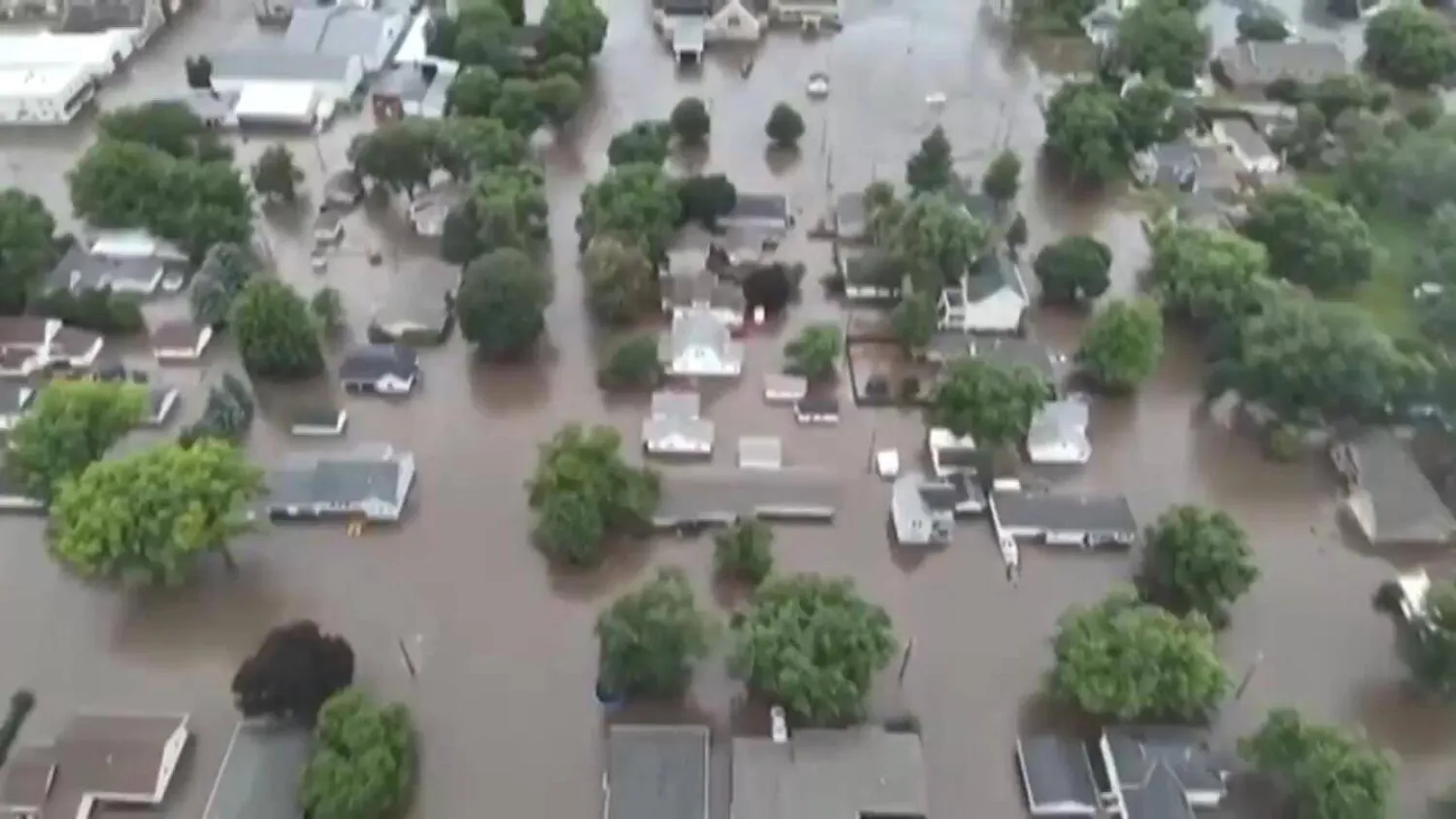Floodwaters forced people out of their homes in parts of Iowa, the result of weeks of rain, while much of the United States longed for relief Saturday from yet another round of extraordinary heat.
Sirens blared at 2 a.m. in Rock Valley, Iowa, population 4,200, where people in hundreds of homes were told to get out as the Rock River could no longer take rain that has slammed the region. The city lacked running water because wells were unusable.
Mayor Kevin Van Otterloo said a state helicopter was on its way to help but was called off when boats were able to reach stranded residents.
“We've had so much rain here,” he said. “We had 4 inches last night in an hour and a half time. Our ground just cannot take anymore.”
Gov. Kim Reynolds declared a disaster for 21 counties in northern Iowa, including Sioux County, which includes Rock Valley. In drone video posted by the local sheriff, no streets were visible, just roofs and treetops poking above the water, The AP reported.
In South Dakota, Gov. Kristi Noem declared an emergency after the southeastern part of the state received heavy rainfall. The town of Canton, 30 miles (48 kilometers) southeast of Sioux Falls, has received 18 inches (45.72 centimeters) of rain.
Several highways were closed, including a key stretch of Interstate 29 south of Sioux Falls that later reopened. Sioux Falls, the state’s largest city, had more than 7 inches (17.7 centimeters) of rain in three days.
“Even though the rain is slowing down, we need to keep vigilant,” said Noem. “The worst of the flooding along our rivers will be Monday and Tuesday.”
Elsewhere in the US, the miserable grip of heat and humidity continued. The National Weather Service said roughly 15 million people were under a heat warning — the highest level of alert — while another 90 million were under a heat advisory. Millions across the country have had their lives disrupted by stretches of unusually high temperatures.
Last year the US experienced the most heat waves since 1936, experts said. An AP analysis of data from the Centers for Disease Control and Prevention found that excessive heat contributed to more than 2,300 deaths, the highest in 45 years of records.
Temperatures around 100 degrees Fahrenheit (37.8 degrees Celsius) were predicted for Washington, D.C., and Richmond, Virginia, while Philadelphia; Newark, New Jersey; Columbus, Ohio; and Detroit were bracing for the high 90s.
Heat-related hospital visits in New York state lately were 500% higher than on the average June day, according to the Department of Health.
“We still have this prolonged heat wave across portions of the Ohio Valley and into the Northeast,” weather service meteorologist Marc Chenard said. “We get a little bit of relief by early in the week, at least in the eastern US, the Northeast, but in general above-normal temperatures are going to cover a large portion of the country even into next week.”
In southeastern Michigan, DTE Energy said 7,400 customers remained without power as of Saturday afternoon due to storm-related outages, down from 75,000 earlier in the week.
A heat index of around 100 Fahrenheit (37.8 Celsius) didn't stop Florida couple Judy and Bill Watson from watching the Tigers play the White Sox at Detroit's Comerica Park. Their afternoon visit was a milestone: Bill Watson has now seen games at all 30 MLB ballparks.
“We're from Florida. You might be interviewing the wrong people about heat,” the 71-year-old Bradenton man said with a smile. “We drank water, beer occasionally. We were just happy it didn't get rained out.”
Across the country in California, temperatures in the state’s Central Valley were expected to reach as high as 106 Fahrenheit (41.1 Celsius), and the NWS issued a heat advisory through 8 p.m. Nearly 4,000 homes and businesses in Sacramento lost power for less than an hour in the middle of the day, the Sacramento Bee reported.
In Iowa, power was cut off at wastewater treatment plants in Hawarden and Spencer, which together have 14,000 residents.
Aiden Engelkes said he and his girlfriend grabbed clothes, cats and bottled water and left their flooded first-floor apartment in Spencer for a friend's dry space on the fourth floor. His Chevy SUV was under the roiling water outside, except for a bit of its antenna. Across the street, he said, friends were on a roof waiting for help.
“It’s terrifying,” said Engelkes, 20.
While the chances for rain were forecast as small into the middle of next week, the National Weather Service predicted expanded flooding before then in the area as high water moved downstream on several rivers in northern Iowa.
Flooding also closed state highways and county roads in southern Minnesota. Windom, a town of about 4,800 people, received 1.25 inches (3.2 centimeters) of rain on top of earlier heavy downpours, and the Des Moines River there had a record crest.
“We’re having a tough time just keeping up, putting up barricades,” city council member Jenny Quaid said. “We put barricades up, and then all of a sudden the water’s rising so much, the barricade’s way back in the water.”
In New Mexico, heavy rain and flash flood warnings prompted officials to order some evacuations, with shelters set up for displaced residents.
The NWS announced a flash flood emergency on Friday night through early Saturday. The impacted areas included the city of Las Vegas, New Mexico, and communities near Albuquerque.
In Ruidoso, a mountain village in New Mexico, full-time residents will be allowed to return Monday after they were forced out by wildfires, though everyday life won't return to normal.
“You’re going to need to bring a week’s worth of food, you’re going to need to bring drinking water,” Mayor Lynn Crawford said on Facebook.









